HRM Challenges: Attracting and Retaining Talent in Construction
VerifiedAdded on 2023/06/11
|12
|3504
|91
Report
AI Summary
This report examines the critical challenges faced by the construction industry in attracting and retaining a skilled workforce. It begins with an introduction to the increasing importance of talent management in today's competitive market, highlighting the shift from an industrial to an intellectual capital age. A literature review analyzes job design, performance appraisal, cross-cultural frameworks, sustainability competencies, and construction management approaches, emphasizing the need for work-life balance, employee development, and effective communication in diverse teams. The report argues that demographic changes, high turnover, and economic growth intensify the competition for talented workers. It recommends prioritizing talent management, rejuvenating corporate culture, investing in diversity, and leveraging technology and innovation to overcome these challenges. The conclusion stresses the importance of adapting to the needs of Generation Y employees and creating a supportive environment to retain valuable knowledge and skills within the construction sector.
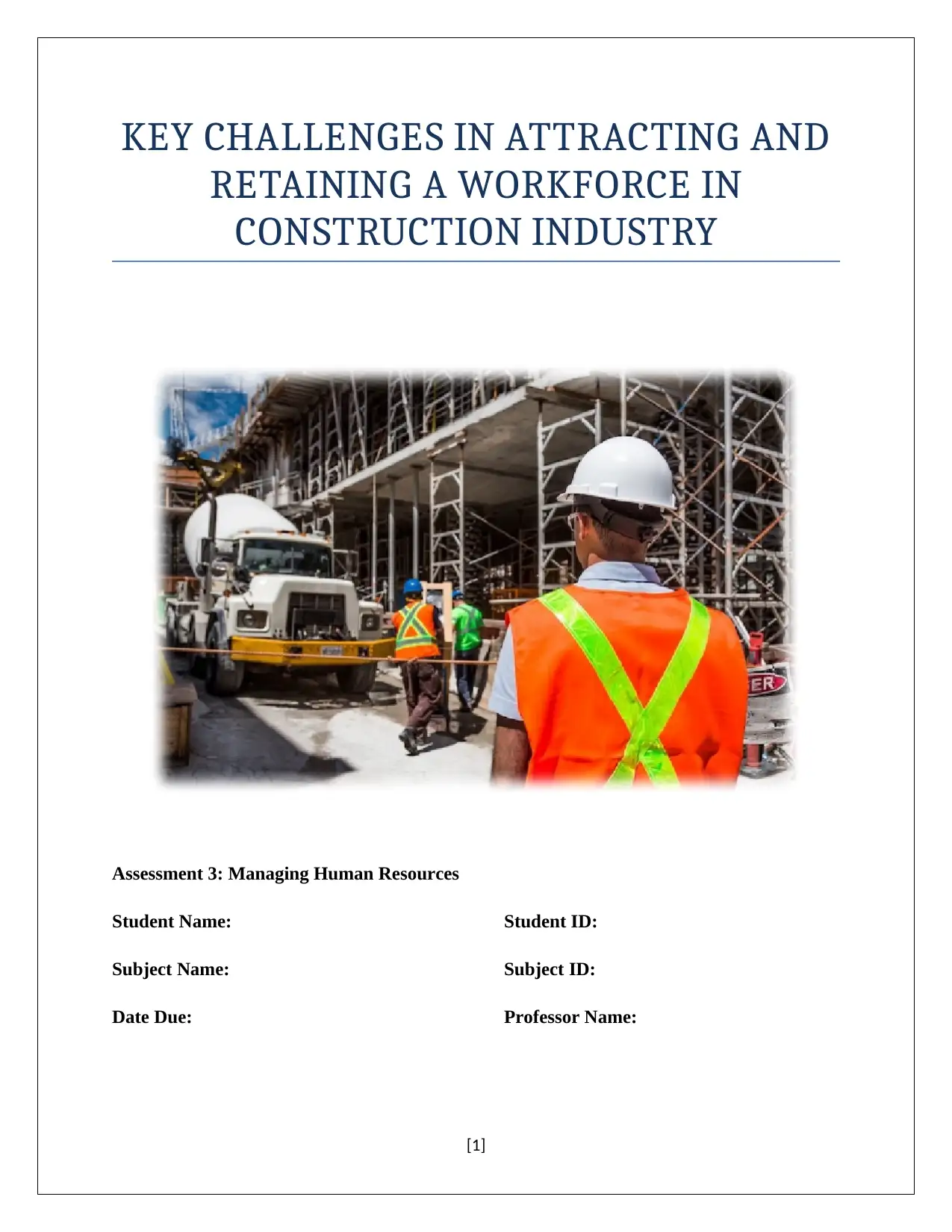
KEY CHALLENGES IN ATTRACTING AND
RETAINING A WORKFORCE IN
CONSTRUCTION INDUSTRY
Assessment 3: Managing Human Resources
Student Name: Student ID:
Subject Name: Subject ID:
Date Due: Professor Name:
[1]
RETAINING A WORKFORCE IN
CONSTRUCTION INDUSTRY
Assessment 3: Managing Human Resources
Student Name: Student ID:
Subject Name: Subject ID:
Date Due: Professor Name:
[1]
Paraphrase This Document
Need a fresh take? Get an instant paraphrase of this document with our AI Paraphraser
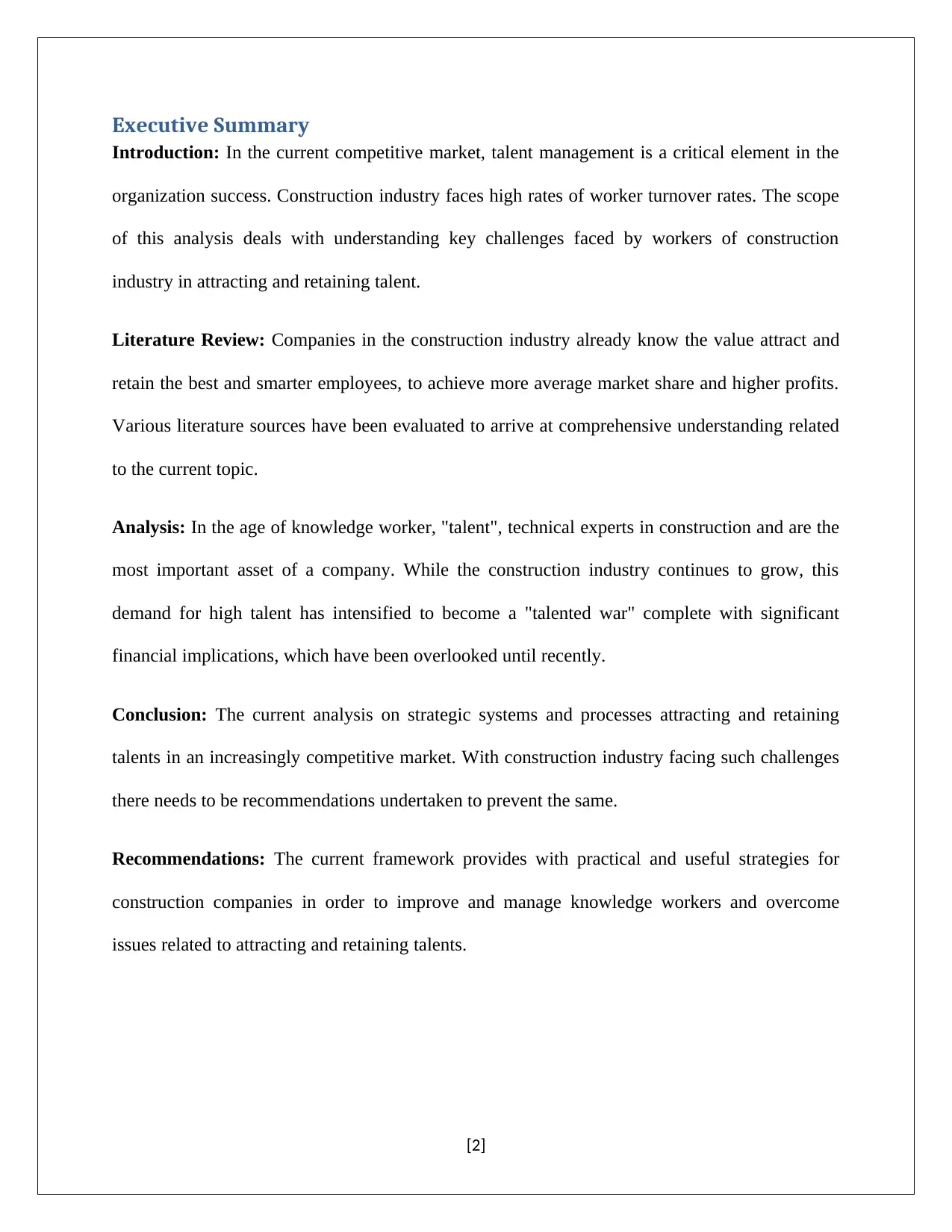
Executive Summary
Introduction: In the current competitive market, talent management is a critical element in the
organization success. Construction industry faces high rates of worker turnover rates. The scope
of this analysis deals with understanding key challenges faced by workers of construction
industry in attracting and retaining talent.
Literature Review: Companies in the construction industry already know the value attract and
retain the best and smarter employees, to achieve more average market share and higher profits.
Various literature sources have been evaluated to arrive at comprehensive understanding related
to the current topic.
Analysis: In the age of knowledge worker, "talent", technical experts in construction and are the
most important asset of a company. While the construction industry continues to grow, this
demand for high talent has intensified to become a "talented war" complete with significant
financial implications, which have been overlooked until recently.
Conclusion: The current analysis on strategic systems and processes attracting and retaining
talents in an increasingly competitive market. With construction industry facing such challenges
there needs to be recommendations undertaken to prevent the same.
Recommendations: The current framework provides with practical and useful strategies for
construction companies in order to improve and manage knowledge workers and overcome
issues related to attracting and retaining talents.
[2]
Introduction: In the current competitive market, talent management is a critical element in the
organization success. Construction industry faces high rates of worker turnover rates. The scope
of this analysis deals with understanding key challenges faced by workers of construction
industry in attracting and retaining talent.
Literature Review: Companies in the construction industry already know the value attract and
retain the best and smarter employees, to achieve more average market share and higher profits.
Various literature sources have been evaluated to arrive at comprehensive understanding related
to the current topic.
Analysis: In the age of knowledge worker, "talent", technical experts in construction and are the
most important asset of a company. While the construction industry continues to grow, this
demand for high talent has intensified to become a "talented war" complete with significant
financial implications, which have been overlooked until recently.
Conclusion: The current analysis on strategic systems and processes attracting and retaining
talents in an increasingly competitive market. With construction industry facing such challenges
there needs to be recommendations undertaken to prevent the same.
Recommendations: The current framework provides with practical and useful strategies for
construction companies in order to improve and manage knowledge workers and overcome
issues related to attracting and retaining talents.
[2]
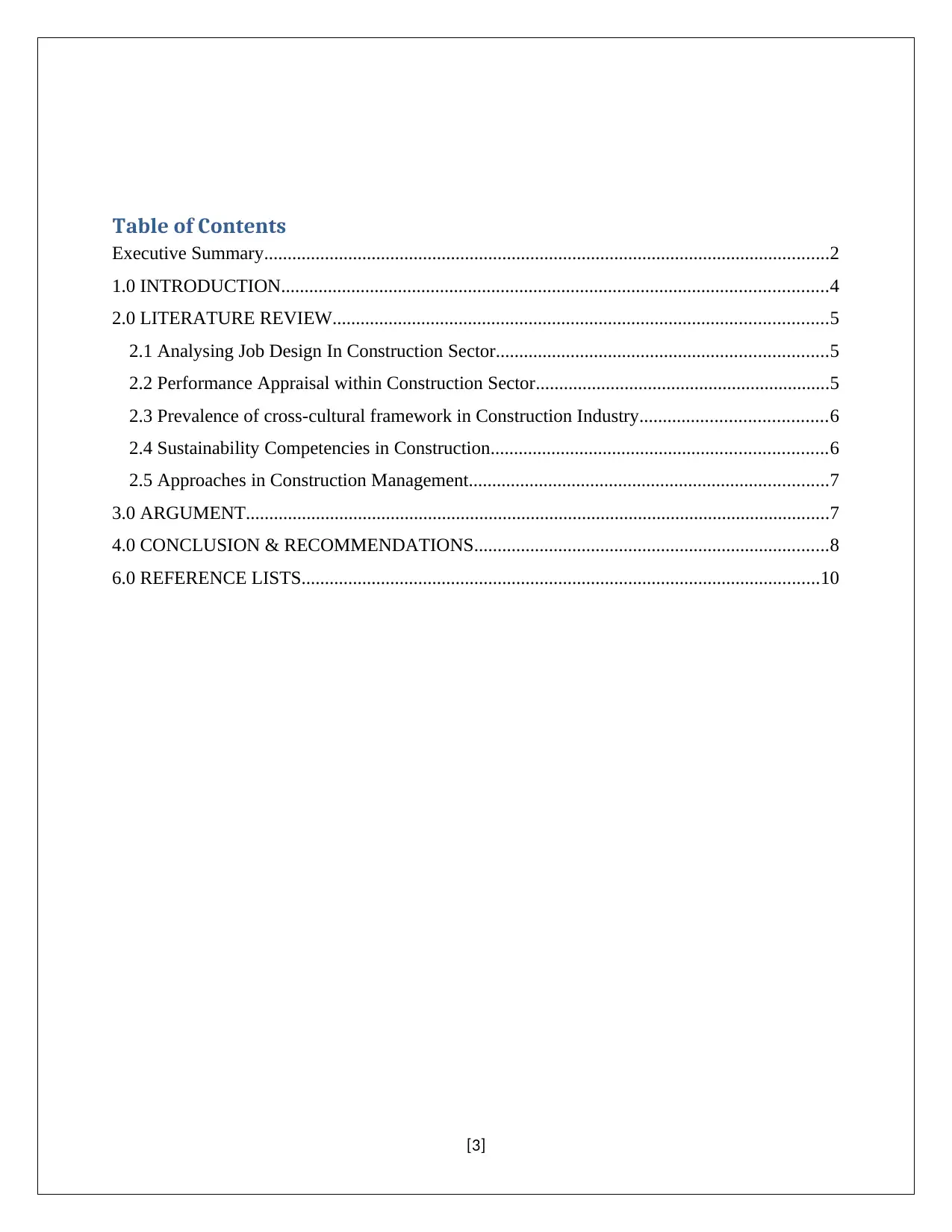
Table of Contents
Executive Summary.........................................................................................................................2
1.0 INTRODUCTION.....................................................................................................................4
2.0 LITERATURE REVIEW..........................................................................................................5
2.1 Analysing Job Design In Construction Sector.......................................................................5
2.2 Performance Appraisal within Construction Sector...............................................................5
2.3 Prevalence of cross-cultural framework in Construction Industry........................................6
2.4 Sustainability Competencies in Construction........................................................................6
2.5 Approaches in Construction Management.............................................................................7
3.0 ARGUMENT.............................................................................................................................7
4.0 CONCLUSION & RECOMMENDATIONS............................................................................8
6.0 REFERENCE LISTS...............................................................................................................10
[3]
Executive Summary.........................................................................................................................2
1.0 INTRODUCTION.....................................................................................................................4
2.0 LITERATURE REVIEW..........................................................................................................5
2.1 Analysing Job Design In Construction Sector.......................................................................5
2.2 Performance Appraisal within Construction Sector...............................................................5
2.3 Prevalence of cross-cultural framework in Construction Industry........................................6
2.4 Sustainability Competencies in Construction........................................................................6
2.5 Approaches in Construction Management.............................................................................7
3.0 ARGUMENT.............................................................................................................................7
4.0 CONCLUSION & RECOMMENDATIONS............................................................................8
6.0 REFERENCE LISTS...............................................................................................................10
[3]
⊘ This is a preview!⊘
Do you want full access?
Subscribe today to unlock all pages.

Trusted by 1+ million students worldwide
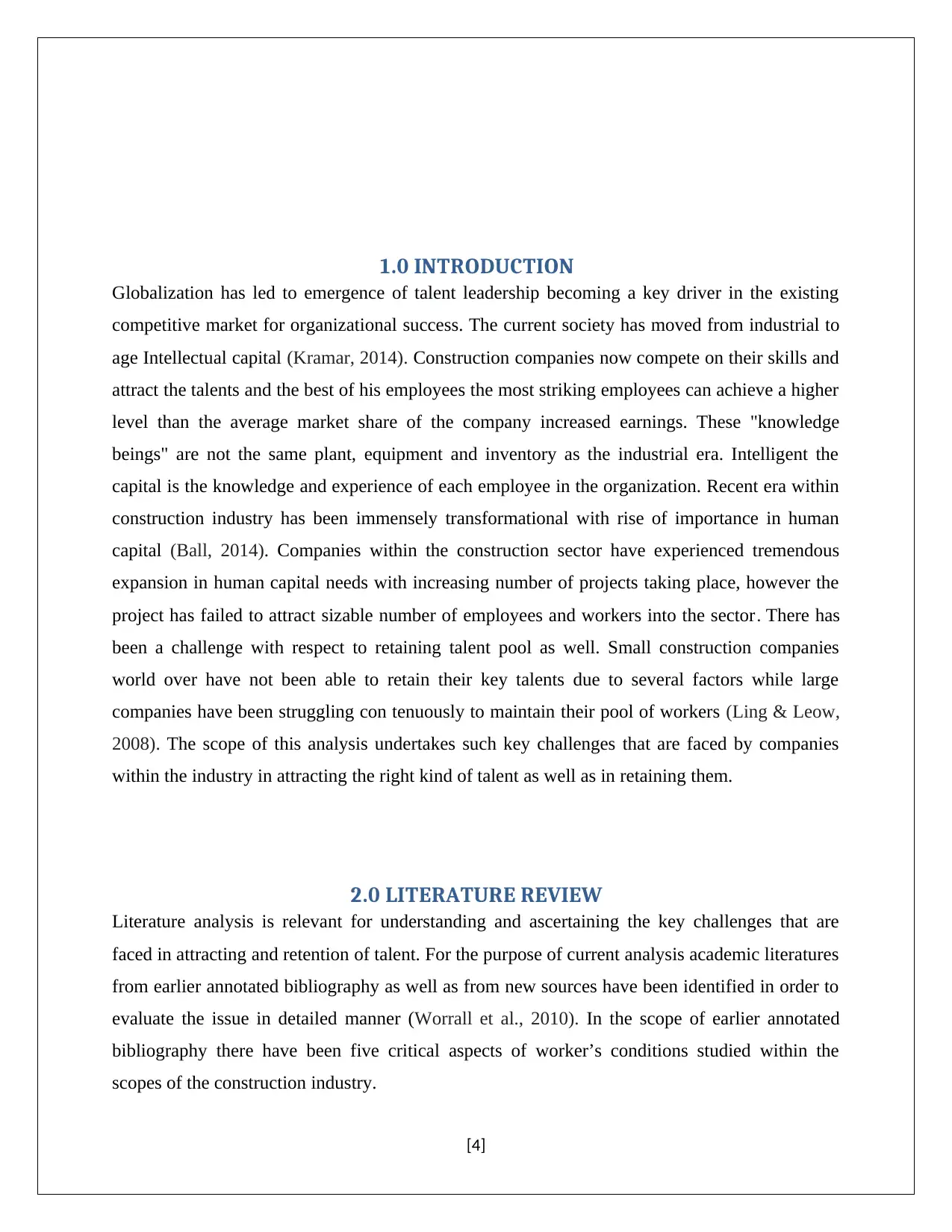
1.0 INTRODUCTION
Globalization has led to emergence of talent leadership becoming a key driver in the existing
competitive market for organizational success. The current society has moved from industrial to
age Intellectual capital (Kramar, 2014). Construction companies now compete on their skills and
attract the talents and the best of his employees the most striking employees can achieve a higher
level than the average market share of the company increased earnings. These "knowledge
beings" are not the same plant, equipment and inventory as the industrial era. Intelligent the
capital is the knowledge and experience of each employee in the organization. Recent era within
construction industry has been immensely transformational with rise of importance in human
capital (Ball, 2014). Companies within the construction sector have experienced tremendous
expansion in human capital needs with increasing number of projects taking place, however the
project has failed to attract sizable number of employees and workers into the sector. There has
been a challenge with respect to retaining talent pool as well. Small construction companies
world over have not been able to retain their key talents due to several factors while large
companies have been struggling con tenuously to maintain their pool of workers (Ling & Leow,
2008). The scope of this analysis undertakes such key challenges that are faced by companies
within the industry in attracting the right kind of talent as well as in retaining them.
2.0 LITERATURE REVIEW
Literature analysis is relevant for understanding and ascertaining the key challenges that are
faced in attracting and retention of talent. For the purpose of current analysis academic literatures
from earlier annotated bibliography as well as from new sources have been identified in order to
evaluate the issue in detailed manner (Worrall et al., 2010). In the scope of earlier annotated
bibliography there have been five critical aspects of worker’s conditions studied within the
scopes of the construction industry.
[4]
Globalization has led to emergence of talent leadership becoming a key driver in the existing
competitive market for organizational success. The current society has moved from industrial to
age Intellectual capital (Kramar, 2014). Construction companies now compete on their skills and
attract the talents and the best of his employees the most striking employees can achieve a higher
level than the average market share of the company increased earnings. These "knowledge
beings" are not the same plant, equipment and inventory as the industrial era. Intelligent the
capital is the knowledge and experience of each employee in the organization. Recent era within
construction industry has been immensely transformational with rise of importance in human
capital (Ball, 2014). Companies within the construction sector have experienced tremendous
expansion in human capital needs with increasing number of projects taking place, however the
project has failed to attract sizable number of employees and workers into the sector. There has
been a challenge with respect to retaining talent pool as well. Small construction companies
world over have not been able to retain their key talents due to several factors while large
companies have been struggling con tenuously to maintain their pool of workers (Ling & Leow,
2008). The scope of this analysis undertakes such key challenges that are faced by companies
within the industry in attracting the right kind of talent as well as in retaining them.
2.0 LITERATURE REVIEW
Literature analysis is relevant for understanding and ascertaining the key challenges that are
faced in attracting and retention of talent. For the purpose of current analysis academic literatures
from earlier annotated bibliography as well as from new sources have been identified in order to
evaluate the issue in detailed manner (Worrall et al., 2010). In the scope of earlier annotated
bibliography there have been five critical aspects of worker’s conditions studied within the
scopes of the construction industry.
[4]
Paraphrase This Document
Need a fresh take? Get an instant paraphrase of this document with our AI Paraphraser
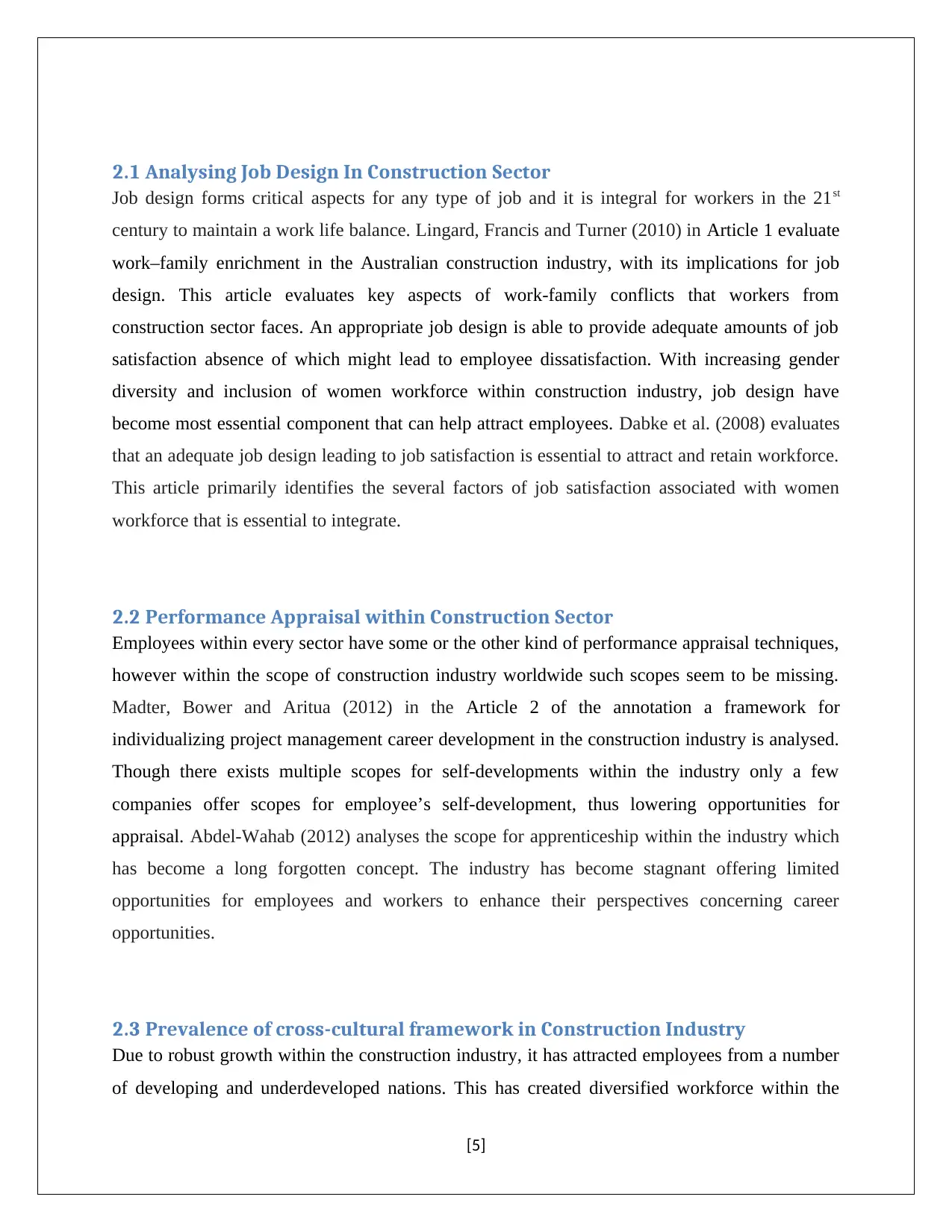
2.1 Analysing Job Design In Construction Sector
Job design forms critical aspects for any type of job and it is integral for workers in the 21st
century to maintain a work life balance. Lingard, Francis and Turner (2010) in Article 1 evaluate
work–family enrichment in the Australian construction industry, with its implications for job
design. This article evaluates key aspects of work-family conflicts that workers from
construction sector faces. An appropriate job design is able to provide adequate amounts of job
satisfaction absence of which might lead to employee dissatisfaction. With increasing gender
diversity and inclusion of women workforce within construction industry, job design have
become most essential component that can help attract employees. Dabke et al. (2008) evaluates
that an adequate job design leading to job satisfaction is essential to attract and retain workforce.
This article primarily identifies the several factors of job satisfaction associated with women
workforce that is essential to integrate.
2.2 Performance Appraisal within Construction Sector
Employees within every sector have some or the other kind of performance appraisal techniques,
however within the scope of construction industry worldwide such scopes seem to be missing.
Madter, Bower and Aritua (2012) in the Article 2 of the annotation a framework for
individualizing project management career development in the construction industry is analysed.
Though there exists multiple scopes for self-developments within the industry only a few
companies offer scopes for employee’s self-development, thus lowering opportunities for
appraisal. Abdel-Wahab (2012) analyses the scope for apprenticeship within the industry which
has become a long forgotten concept. The industry has become stagnant offering limited
opportunities for employees and workers to enhance their perspectives concerning career
opportunities.
2.3 Prevalence of cross-cultural framework in Construction Industry
Due to robust growth within the construction industry, it has attracted employees from a number
of developing and underdeveloped nations. This has created diversified workforce within the
[5]
Job design forms critical aspects for any type of job and it is integral for workers in the 21st
century to maintain a work life balance. Lingard, Francis and Turner (2010) in Article 1 evaluate
work–family enrichment in the Australian construction industry, with its implications for job
design. This article evaluates key aspects of work-family conflicts that workers from
construction sector faces. An appropriate job design is able to provide adequate amounts of job
satisfaction absence of which might lead to employee dissatisfaction. With increasing gender
diversity and inclusion of women workforce within construction industry, job design have
become most essential component that can help attract employees. Dabke et al. (2008) evaluates
that an adequate job design leading to job satisfaction is essential to attract and retain workforce.
This article primarily identifies the several factors of job satisfaction associated with women
workforce that is essential to integrate.
2.2 Performance Appraisal within Construction Sector
Employees within every sector have some or the other kind of performance appraisal techniques,
however within the scope of construction industry worldwide such scopes seem to be missing.
Madter, Bower and Aritua (2012) in the Article 2 of the annotation a framework for
individualizing project management career development in the construction industry is analysed.
Though there exists multiple scopes for self-developments within the industry only a few
companies offer scopes for employee’s self-development, thus lowering opportunities for
appraisal. Abdel-Wahab (2012) analyses the scope for apprenticeship within the industry which
has become a long forgotten concept. The industry has become stagnant offering limited
opportunities for employees and workers to enhance their perspectives concerning career
opportunities.
2.3 Prevalence of cross-cultural framework in Construction Industry
Due to robust growth within the construction industry, it has attracted employees from a number
of developing and underdeveloped nations. This has created diversified workforce within the
[5]
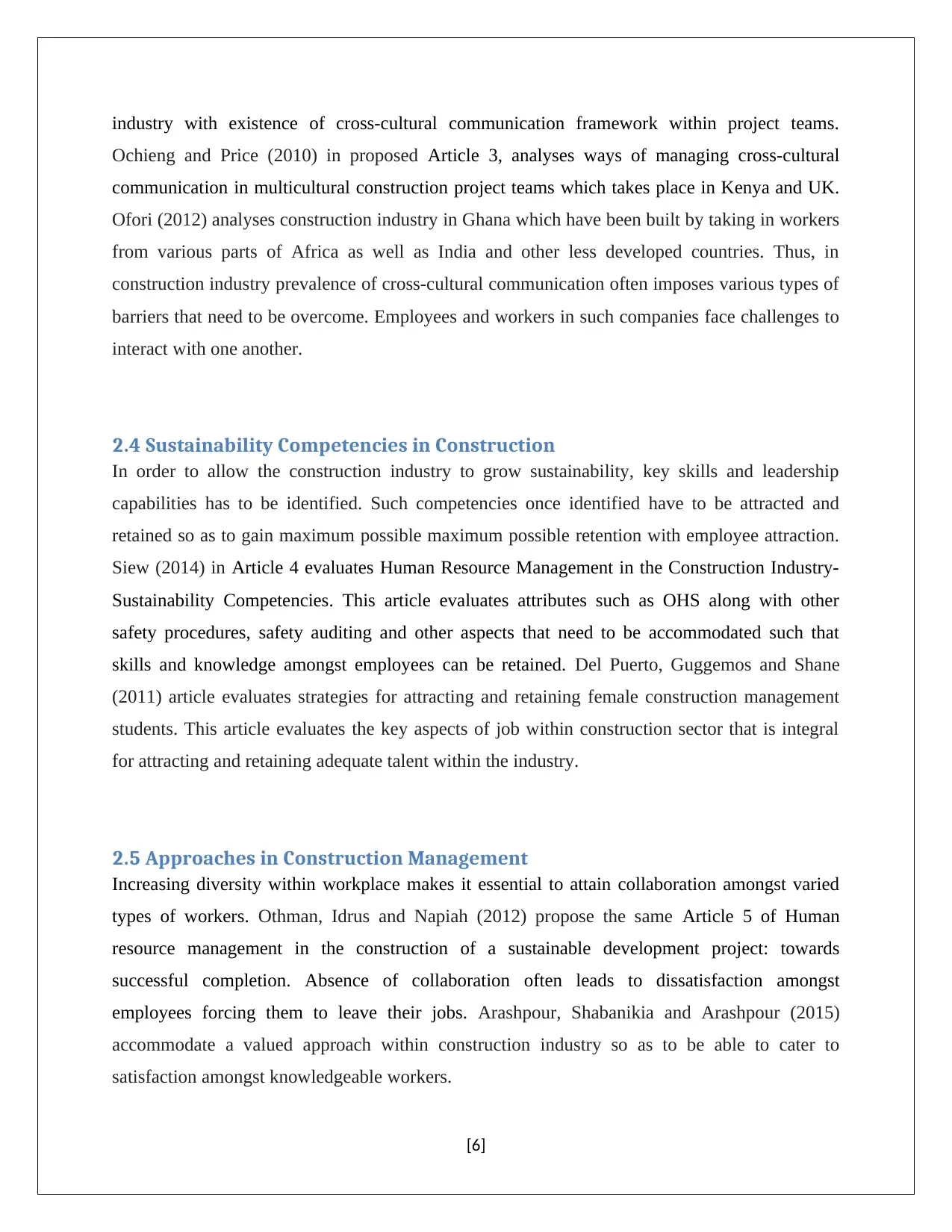
industry with existence of cross-cultural communication framework within project teams.
Ochieng and Price (2010) in proposed Article 3, analyses ways of managing cross-cultural
communication in multicultural construction project teams which takes place in Kenya and UK.
Ofori (2012) analyses construction industry in Ghana which have been built by taking in workers
from various parts of Africa as well as India and other less developed countries. Thus, in
construction industry prevalence of cross-cultural communication often imposes various types of
barriers that need to be overcome. Employees and workers in such companies face challenges to
interact with one another.
2.4 Sustainability Competencies in Construction
In order to allow the construction industry to grow sustainability, key skills and leadership
capabilities has to be identified. Such competencies once identified have to be attracted and
retained so as to gain maximum possible maximum possible retention with employee attraction.
Siew (2014) in Article 4 evaluates Human Resource Management in the Construction Industry-
Sustainability Competencies. This article evaluates attributes such as OHS along with other
safety procedures, safety auditing and other aspects that need to be accommodated such that
skills and knowledge amongst employees can be retained. Del Puerto, Guggemos and Shane
(2011) article evaluates strategies for attracting and retaining female construction management
students. This article evaluates the key aspects of job within construction sector that is integral
for attracting and retaining adequate talent within the industry.
2.5 Approaches in Construction Management
Increasing diversity within workplace makes it essential to attain collaboration amongst varied
types of workers. Othman, Idrus and Napiah (2012) propose the same Article 5 of Human
resource management in the construction of a sustainable development project: towards
successful completion. Absence of collaboration often leads to dissatisfaction amongst
employees forcing them to leave their jobs. Arashpour, Shabanikia and Arashpour (2015)
accommodate a valued approach within construction industry so as to be able to cater to
satisfaction amongst knowledgeable workers.
[6]
Ochieng and Price (2010) in proposed Article 3, analyses ways of managing cross-cultural
communication in multicultural construction project teams which takes place in Kenya and UK.
Ofori (2012) analyses construction industry in Ghana which have been built by taking in workers
from various parts of Africa as well as India and other less developed countries. Thus, in
construction industry prevalence of cross-cultural communication often imposes various types of
barriers that need to be overcome. Employees and workers in such companies face challenges to
interact with one another.
2.4 Sustainability Competencies in Construction
In order to allow the construction industry to grow sustainability, key skills and leadership
capabilities has to be identified. Such competencies once identified have to be attracted and
retained so as to gain maximum possible maximum possible retention with employee attraction.
Siew (2014) in Article 4 evaluates Human Resource Management in the Construction Industry-
Sustainability Competencies. This article evaluates attributes such as OHS along with other
safety procedures, safety auditing and other aspects that need to be accommodated such that
skills and knowledge amongst employees can be retained. Del Puerto, Guggemos and Shane
(2011) article evaluates strategies for attracting and retaining female construction management
students. This article evaluates the key aspects of job within construction sector that is integral
for attracting and retaining adequate talent within the industry.
2.5 Approaches in Construction Management
Increasing diversity within workplace makes it essential to attain collaboration amongst varied
types of workers. Othman, Idrus and Napiah (2012) propose the same Article 5 of Human
resource management in the construction of a sustainable development project: towards
successful completion. Absence of collaboration often leads to dissatisfaction amongst
employees forcing them to leave their jobs. Arashpour, Shabanikia and Arashpour (2015)
accommodate a valued approach within construction industry so as to be able to cater to
satisfaction amongst knowledgeable workers.
[6]
⊘ This is a preview!⊘
Do you want full access?
Subscribe today to unlock all pages.

Trusted by 1+ million students worldwide
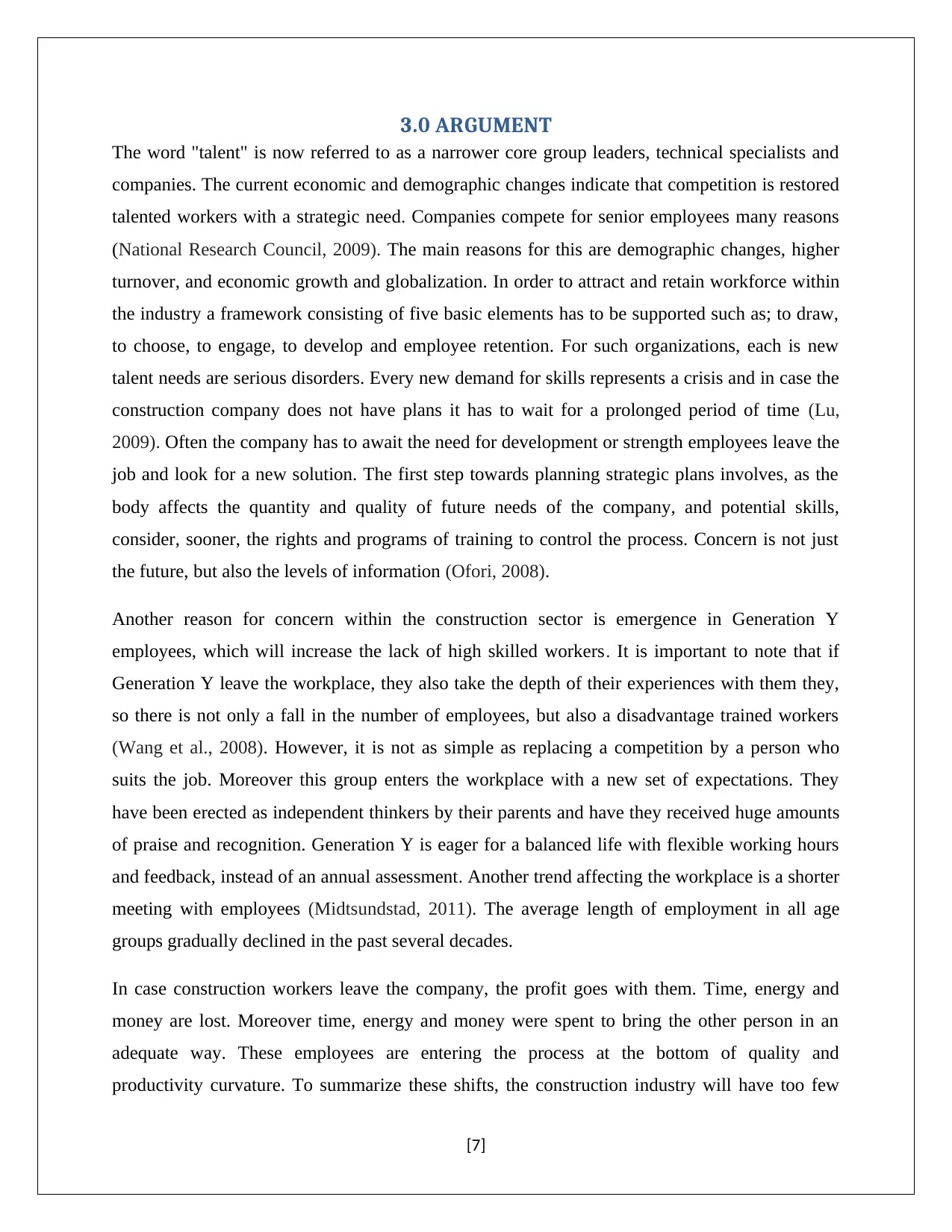
3.0 ARGUMENT
The word "talent" is now referred to as a narrower core group leaders, technical specialists and
companies. The current economic and demographic changes indicate that competition is restored
talented workers with a strategic need. Companies compete for senior employees many reasons
(National Research Council, 2009). The main reasons for this are demographic changes, higher
turnover, and economic growth and globalization. In order to attract and retain workforce within
the industry a framework consisting of five basic elements has to be supported such as; to draw,
to choose, to engage, to develop and employee retention. For such organizations, each is new
talent needs are serious disorders. Every new demand for skills represents a crisis and in case the
construction company does not have plans it has to wait for a prolonged period of time (Lu,
2009). Often the company has to await the need for development or strength employees leave the
job and look for a new solution. The first step towards planning strategic plans involves, as the
body affects the quantity and quality of future needs of the company, and potential skills,
consider, sooner, the rights and programs of training to control the process. Concern is not just
the future, but also the levels of information (Ofori, 2008).
Another reason for concern within the construction sector is emergence in Generation Y
employees, which will increase the lack of high skilled workers. It is important to note that if
Generation Y leave the workplace, they also take the depth of their experiences with them they,
so there is not only a fall in the number of employees, but also a disadvantage trained workers
(Wang et al., 2008). However, it is not as simple as replacing a competition by a person who
suits the job. Moreover this group enters the workplace with a new set of expectations. They
have been erected as independent thinkers by their parents and have they received huge amounts
of praise and recognition. Generation Y is eager for a balanced life with flexible working hours
and feedback, instead of an annual assessment. Another trend affecting the workplace is a shorter
meeting with employees (Midtsundstad, 2011). The average length of employment in all age
groups gradually declined in the past several decades.
In case construction workers leave the company, the profit goes with them. Time, energy and
money are lost. Moreover time, energy and money were spent to bring the other person in an
adequate way. These employees are entering the process at the bottom of quality and
productivity curvature. To summarize these shifts, the construction industry will have too few
[7]
The word "talent" is now referred to as a narrower core group leaders, technical specialists and
companies. The current economic and demographic changes indicate that competition is restored
talented workers with a strategic need. Companies compete for senior employees many reasons
(National Research Council, 2009). The main reasons for this are demographic changes, higher
turnover, and economic growth and globalization. In order to attract and retain workforce within
the industry a framework consisting of five basic elements has to be supported such as; to draw,
to choose, to engage, to develop and employee retention. For such organizations, each is new
talent needs are serious disorders. Every new demand for skills represents a crisis and in case the
construction company does not have plans it has to wait for a prolonged period of time (Lu,
2009). Often the company has to await the need for development or strength employees leave the
job and look for a new solution. The first step towards planning strategic plans involves, as the
body affects the quantity and quality of future needs of the company, and potential skills,
consider, sooner, the rights and programs of training to control the process. Concern is not just
the future, but also the levels of information (Ofori, 2008).
Another reason for concern within the construction sector is emergence in Generation Y
employees, which will increase the lack of high skilled workers. It is important to note that if
Generation Y leave the workplace, they also take the depth of their experiences with them they,
so there is not only a fall in the number of employees, but also a disadvantage trained workers
(Wang et al., 2008). However, it is not as simple as replacing a competition by a person who
suits the job. Moreover this group enters the workplace with a new set of expectations. They
have been erected as independent thinkers by their parents and have they received huge amounts
of praise and recognition. Generation Y is eager for a balanced life with flexible working hours
and feedback, instead of an annual assessment. Another trend affecting the workplace is a shorter
meeting with employees (Midtsundstad, 2011). The average length of employment in all age
groups gradually declined in the past several decades.
In case construction workers leave the company, the profit goes with them. Time, energy and
money are lost. Moreover time, energy and money were spent to bring the other person in an
adequate way. These employees are entering the process at the bottom of quality and
productivity curvature. To summarize these shifts, the construction industry will have too few
[7]
Paraphrase This Document
Need a fresh take? Get an instant paraphrase of this document with our AI Paraphraser
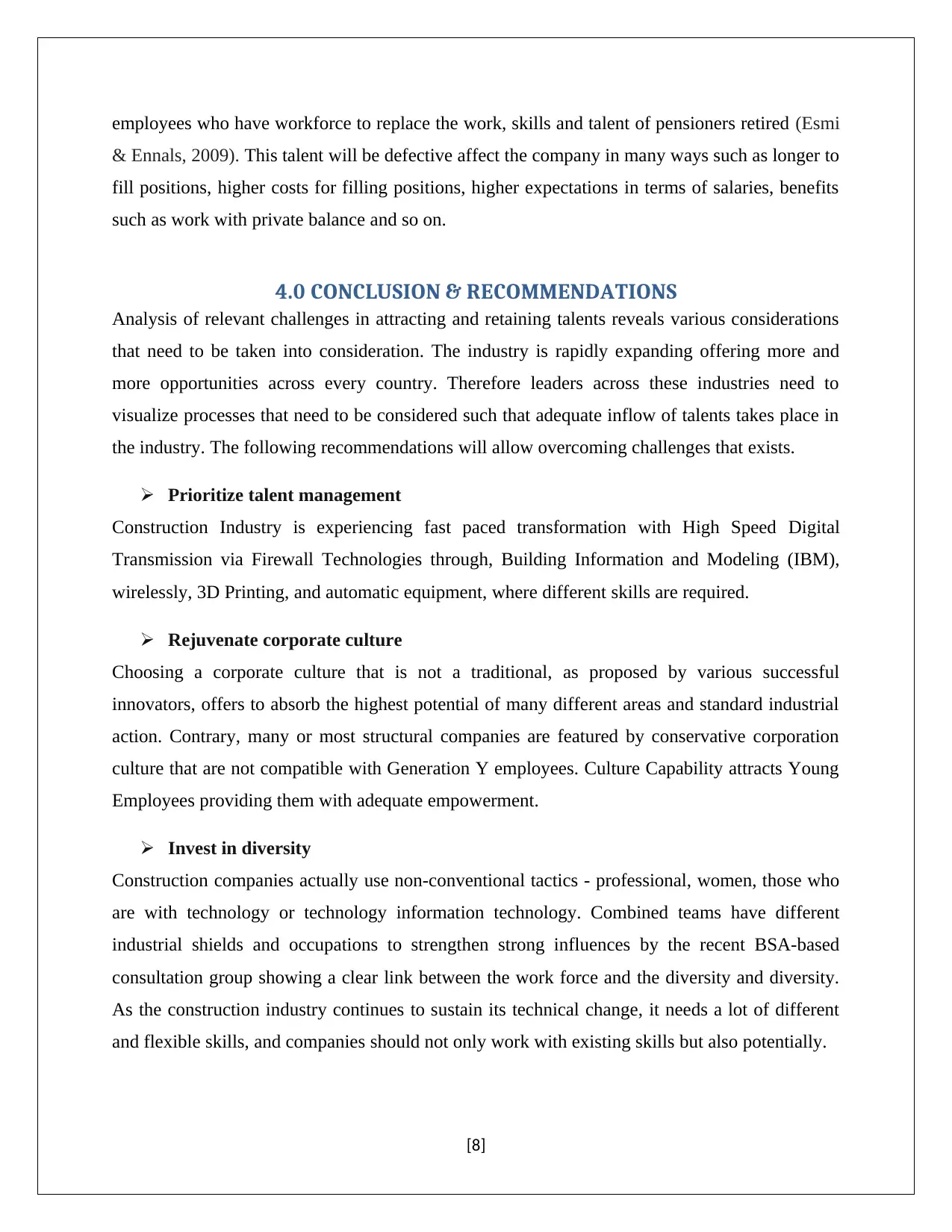
employees who have workforce to replace the work, skills and talent of pensioners retired (Esmi
& Ennals, 2009). This talent will be defective affect the company in many ways such as longer to
fill positions, higher costs for filling positions, higher expectations in terms of salaries, benefits
such as work with private balance and so on.
4.0 CONCLUSION & RECOMMENDATIONS
Analysis of relevant challenges in attracting and retaining talents reveals various considerations
that need to be taken into consideration. The industry is rapidly expanding offering more and
more opportunities across every country. Therefore leaders across these industries need to
visualize processes that need to be considered such that adequate inflow of talents takes place in
the industry. The following recommendations will allow overcoming challenges that exists.
Prioritize talent management
Construction Industry is experiencing fast paced transformation with High Speed Digital
Transmission via Firewall Technologies through, Building Information and Modeling (IBM),
wirelessly, 3D Printing, and automatic equipment, where different skills are required.
Rejuvenate corporate culture
Choosing a corporate culture that is not a traditional, as proposed by various successful
innovators, offers to absorb the highest potential of many different areas and standard industrial
action. Contrary, many or most structural companies are featured by conservative corporation
culture that are not compatible with Generation Y employees. Culture Capability attracts Young
Employees providing them with adequate empowerment.
Invest in diversity
Construction companies actually use non-conventional tactics - professional, women, those who
are with technology or technology information technology. Combined teams have different
industrial shields and occupations to strengthen strong influences by the recent BSA-based
consultation group showing a clear link between the work force and the diversity and diversity.
As the construction industry continues to sustain its technical change, it needs a lot of different
and flexible skills, and companies should not only work with existing skills but also potentially.
[8]
& Ennals, 2009). This talent will be defective affect the company in many ways such as longer to
fill positions, higher costs for filling positions, higher expectations in terms of salaries, benefits
such as work with private balance and so on.
4.0 CONCLUSION & RECOMMENDATIONS
Analysis of relevant challenges in attracting and retaining talents reveals various considerations
that need to be taken into consideration. The industry is rapidly expanding offering more and
more opportunities across every country. Therefore leaders across these industries need to
visualize processes that need to be considered such that adequate inflow of talents takes place in
the industry. The following recommendations will allow overcoming challenges that exists.
Prioritize talent management
Construction Industry is experiencing fast paced transformation with High Speed Digital
Transmission via Firewall Technologies through, Building Information and Modeling (IBM),
wirelessly, 3D Printing, and automatic equipment, where different skills are required.
Rejuvenate corporate culture
Choosing a corporate culture that is not a traditional, as proposed by various successful
innovators, offers to absorb the highest potential of many different areas and standard industrial
action. Contrary, many or most structural companies are featured by conservative corporation
culture that are not compatible with Generation Y employees. Culture Capability attracts Young
Employees providing them with adequate empowerment.
Invest in diversity
Construction companies actually use non-conventional tactics - professional, women, those who
are with technology or technology information technology. Combined teams have different
industrial shields and occupations to strengthen strong influences by the recent BSA-based
consultation group showing a clear link between the work force and the diversity and diversity.
As the construction industry continues to sustain its technical change, it needs a lot of different
and flexible skills, and companies should not only work with existing skills but also potentially.
[8]
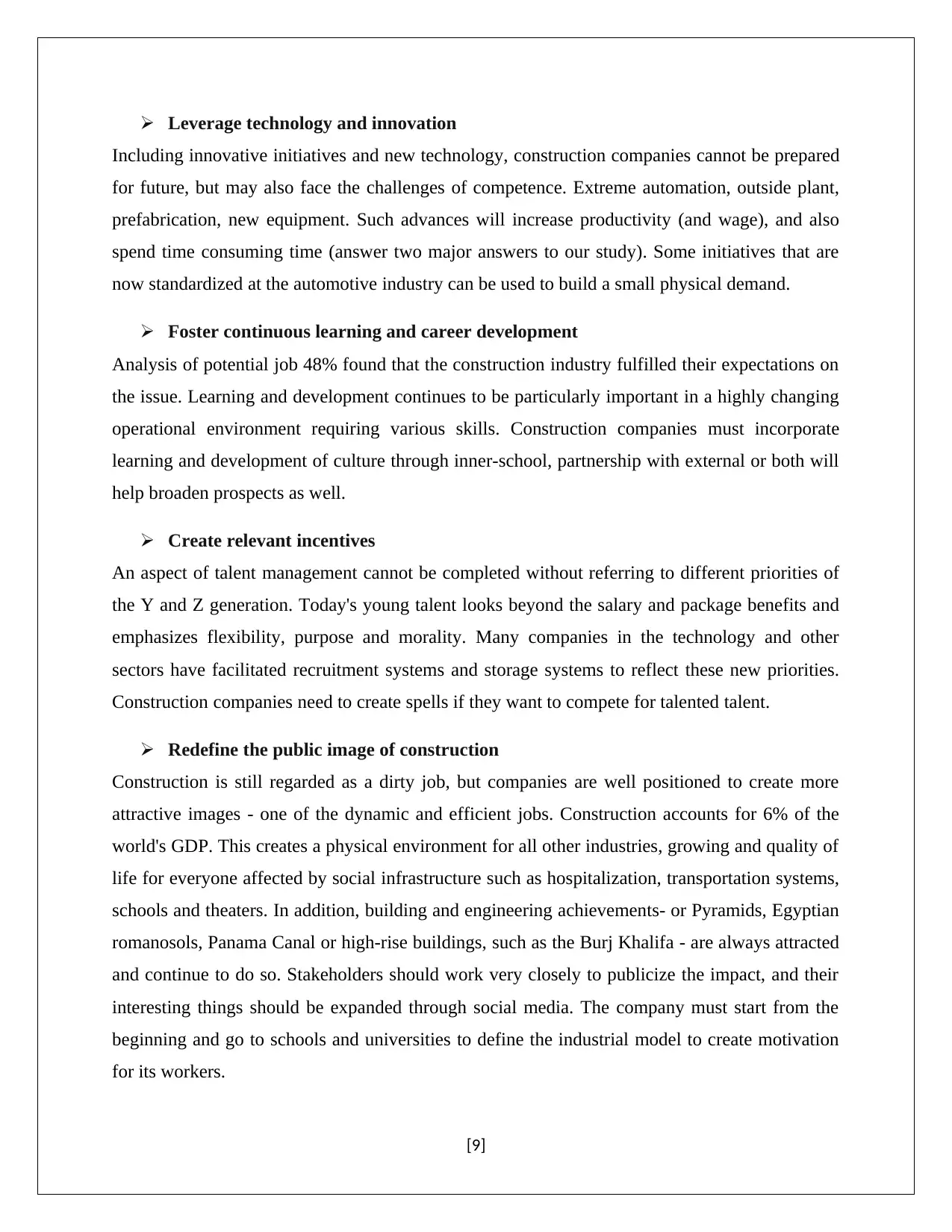
Leverage technology and innovation
Including innovative initiatives and new technology, construction companies cannot be prepared
for future, but may also face the challenges of competence. Extreme automation, outside plant,
prefabrication, new equipment. Such advances will increase productivity (and wage), and also
spend time consuming time (answer two major answers to our study). Some initiatives that are
now standardized at the automotive industry can be used to build a small physical demand.
Foster continuous learning and career development
Analysis of potential job 48% found that the construction industry fulfilled their expectations on
the issue. Learning and development continues to be particularly important in a highly changing
operational environment requiring various skills. Construction companies must incorporate
learning and development of culture through inner-school, partnership with external or both will
help broaden prospects as well.
Create relevant incentives
An aspect of talent management cannot be completed without referring to different priorities of
the Y and Z generation. Today's young talent looks beyond the salary and package benefits and
emphasizes flexibility, purpose and morality. Many companies in the technology and other
sectors have facilitated recruitment systems and storage systems to reflect these new priorities.
Construction companies need to create spells if they want to compete for talented talent.
Redefine the public image of construction
Construction is still regarded as a dirty job, but companies are well positioned to create more
attractive images - one of the dynamic and efficient jobs. Construction accounts for 6% of the
world's GDP. This creates a physical environment for all other industries, growing and quality of
life for everyone affected by social infrastructure such as hospitalization, transportation systems,
schools and theaters. In addition, building and engineering achievements- or Pyramids, Egyptian
romanosols, Panama Canal or high-rise buildings, such as the Burj Khalifa - are always attracted
and continue to do so. Stakeholders should work very closely to publicize the impact, and their
interesting things should be expanded through social media. The company must start from the
beginning and go to schools and universities to define the industrial model to create motivation
for its workers.
[9]
Including innovative initiatives and new technology, construction companies cannot be prepared
for future, but may also face the challenges of competence. Extreme automation, outside plant,
prefabrication, new equipment. Such advances will increase productivity (and wage), and also
spend time consuming time (answer two major answers to our study). Some initiatives that are
now standardized at the automotive industry can be used to build a small physical demand.
Foster continuous learning and career development
Analysis of potential job 48% found that the construction industry fulfilled their expectations on
the issue. Learning and development continues to be particularly important in a highly changing
operational environment requiring various skills. Construction companies must incorporate
learning and development of culture through inner-school, partnership with external or both will
help broaden prospects as well.
Create relevant incentives
An aspect of talent management cannot be completed without referring to different priorities of
the Y and Z generation. Today's young talent looks beyond the salary and package benefits and
emphasizes flexibility, purpose and morality. Many companies in the technology and other
sectors have facilitated recruitment systems and storage systems to reflect these new priorities.
Construction companies need to create spells if they want to compete for talented talent.
Redefine the public image of construction
Construction is still regarded as a dirty job, but companies are well positioned to create more
attractive images - one of the dynamic and efficient jobs. Construction accounts for 6% of the
world's GDP. This creates a physical environment for all other industries, growing and quality of
life for everyone affected by social infrastructure such as hospitalization, transportation systems,
schools and theaters. In addition, building and engineering achievements- or Pyramids, Egyptian
romanosols, Panama Canal or high-rise buildings, such as the Burj Khalifa - are always attracted
and continue to do so. Stakeholders should work very closely to publicize the impact, and their
interesting things should be expanded through social media. The company must start from the
beginning and go to schools and universities to define the industrial model to create motivation
for its workers.
[9]
⊘ This is a preview!⊘
Do you want full access?
Subscribe today to unlock all pages.

Trusted by 1+ million students worldwide
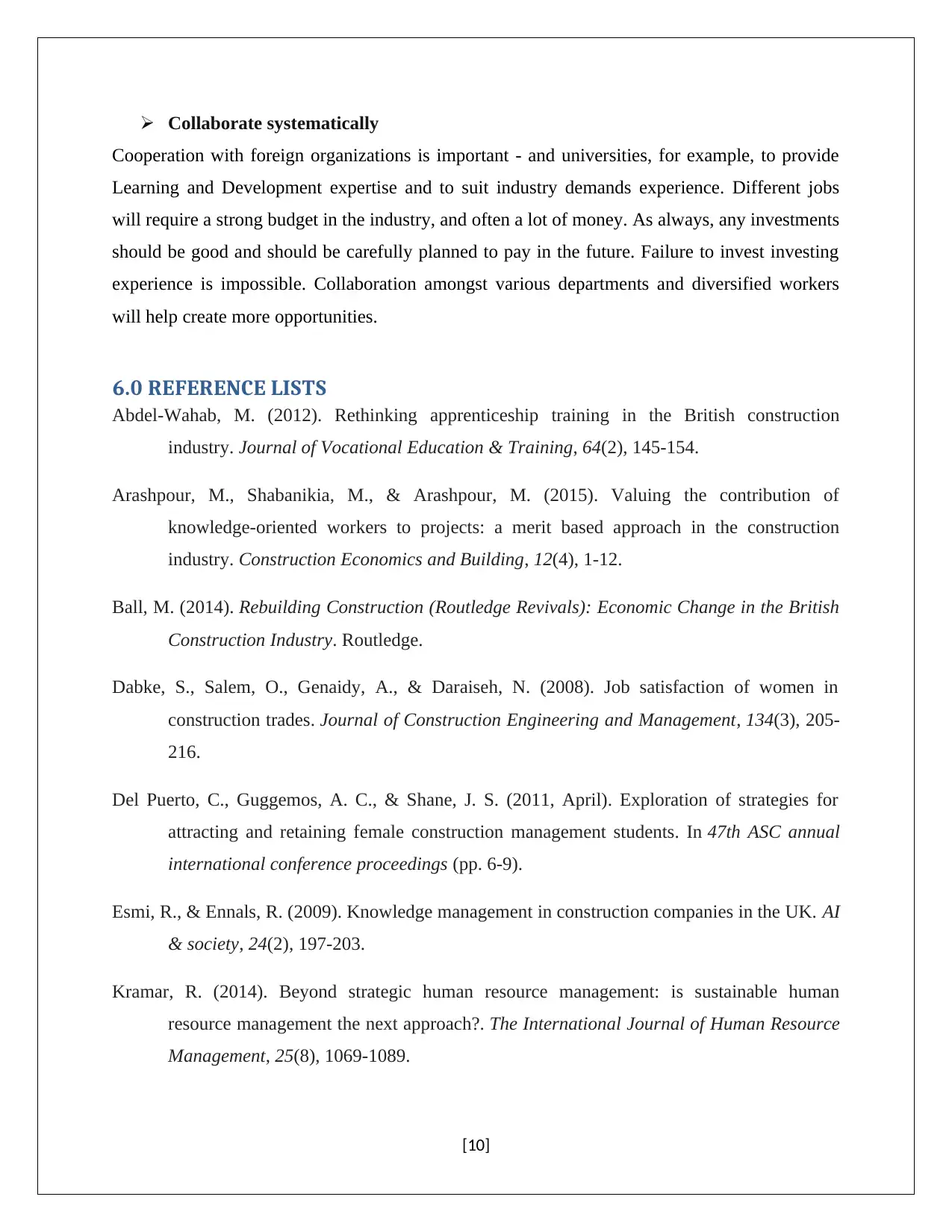
Collaborate systematically
Cooperation with foreign organizations is important - and universities, for example, to provide
Learning and Development expertise and to suit industry demands experience. Different jobs
will require a strong budget in the industry, and often a lot of money. As always, any investments
should be good and should be carefully planned to pay in the future. Failure to invest investing
experience is impossible. Collaboration amongst various departments and diversified workers
will help create more opportunities.
6.0 REFERENCE LISTS
Abdel-Wahab, M. (2012). Rethinking apprenticeship training in the British construction
industry. Journal of Vocational Education & Training, 64(2), 145-154.
Arashpour, M., Shabanikia, M., & Arashpour, M. (2015). Valuing the contribution of
knowledge-oriented workers to projects: a merit based approach in the construction
industry. Construction Economics and Building, 12(4), 1-12.
Ball, M. (2014). Rebuilding Construction (Routledge Revivals): Economic Change in the British
Construction Industry. Routledge.
Dabke, S., Salem, O., Genaidy, A., & Daraiseh, N. (2008). Job satisfaction of women in
construction trades. Journal of Construction Engineering and Management, 134(3), 205-
216.
Del Puerto, C., Guggemos, A. C., & Shane, J. S. (2011, April). Exploration of strategies for
attracting and retaining female construction management students. In 47th ASC annual
international conference proceedings (pp. 6-9).
Esmi, R., & Ennals, R. (2009). Knowledge management in construction companies in the UK. AI
& society, 24(2), 197-203.
Kramar, R. (2014). Beyond strategic human resource management: is sustainable human
resource management the next approach?. The International Journal of Human Resource
Management, 25(8), 1069-1089.
[10]
Cooperation with foreign organizations is important - and universities, for example, to provide
Learning and Development expertise and to suit industry demands experience. Different jobs
will require a strong budget in the industry, and often a lot of money. As always, any investments
should be good and should be carefully planned to pay in the future. Failure to invest investing
experience is impossible. Collaboration amongst various departments and diversified workers
will help create more opportunities.
6.0 REFERENCE LISTS
Abdel-Wahab, M. (2012). Rethinking apprenticeship training in the British construction
industry. Journal of Vocational Education & Training, 64(2), 145-154.
Arashpour, M., Shabanikia, M., & Arashpour, M. (2015). Valuing the contribution of
knowledge-oriented workers to projects: a merit based approach in the construction
industry. Construction Economics and Building, 12(4), 1-12.
Ball, M. (2014). Rebuilding Construction (Routledge Revivals): Economic Change in the British
Construction Industry. Routledge.
Dabke, S., Salem, O., Genaidy, A., & Daraiseh, N. (2008). Job satisfaction of women in
construction trades. Journal of Construction Engineering and Management, 134(3), 205-
216.
Del Puerto, C., Guggemos, A. C., & Shane, J. S. (2011, April). Exploration of strategies for
attracting and retaining female construction management students. In 47th ASC annual
international conference proceedings (pp. 6-9).
Esmi, R., & Ennals, R. (2009). Knowledge management in construction companies in the UK. AI
& society, 24(2), 197-203.
Kramar, R. (2014). Beyond strategic human resource management: is sustainable human
resource management the next approach?. The International Journal of Human Resource
Management, 25(8), 1069-1089.
[10]
Paraphrase This Document
Need a fresh take? Get an instant paraphrase of this document with our AI Paraphraser
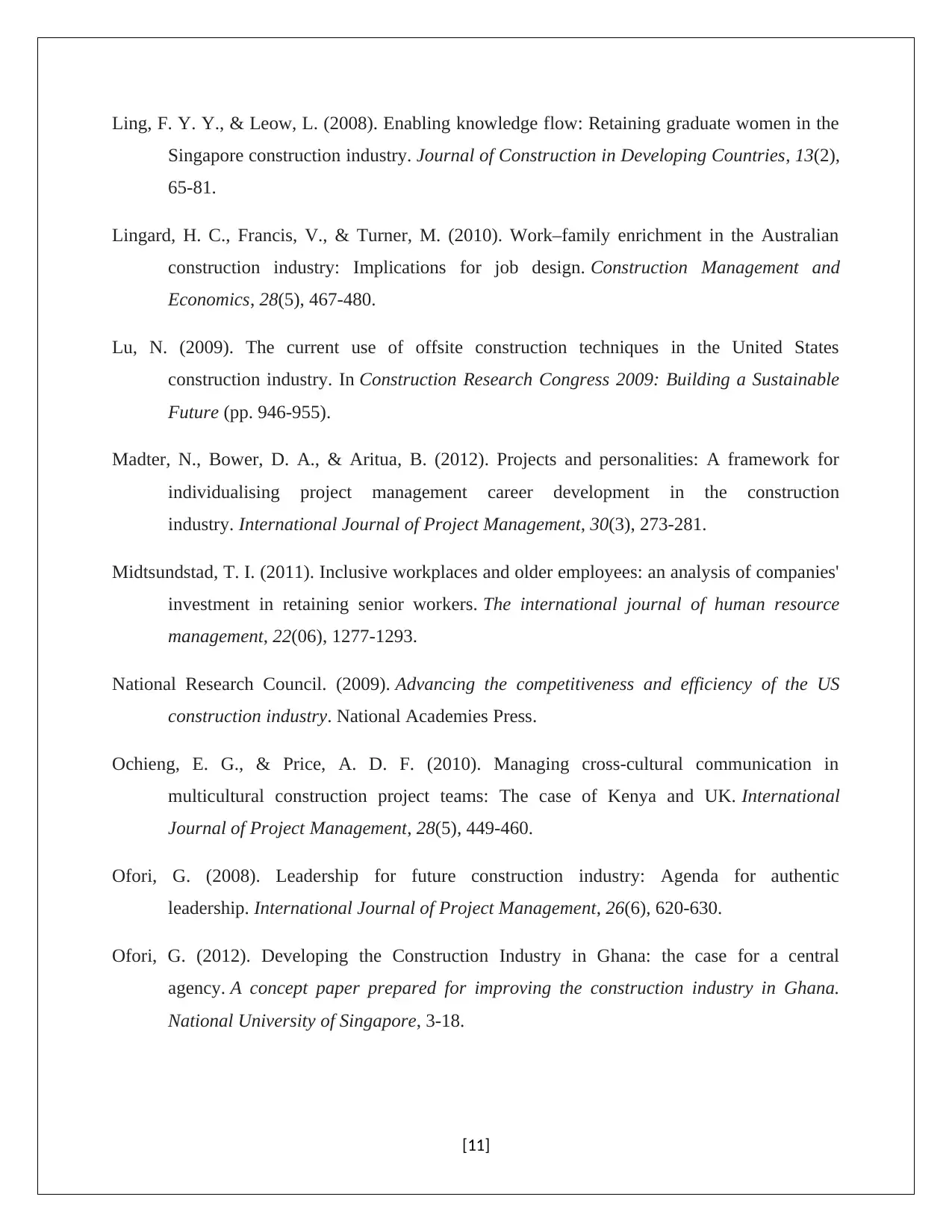
Ling, F. Y. Y., & Leow, L. (2008). Enabling knowledge flow: Retaining graduate women in the
Singapore construction industry. Journal of Construction in Developing Countries, 13(2),
65-81.
Lingard, H. C., Francis, V., & Turner, M. (2010). Work–family enrichment in the Australian
construction industry: Implications for job design. Construction Management and
Economics, 28(5), 467-480.
Lu, N. (2009). The current use of offsite construction techniques in the United States
construction industry. In Construction Research Congress 2009: Building a Sustainable
Future (pp. 946-955).
Madter, N., Bower, D. A., & Aritua, B. (2012). Projects and personalities: A framework for
individualising project management career development in the construction
industry. International Journal of Project Management, 30(3), 273-281.
Midtsundstad, T. I. (2011). Inclusive workplaces and older employees: an analysis of companies'
investment in retaining senior workers. The international journal of human resource
management, 22(06), 1277-1293.
National Research Council. (2009). Advancing the competitiveness and efficiency of the US
construction industry. National Academies Press.
Ochieng, E. G., & Price, A. D. F. (2010). Managing cross-cultural communication in
multicultural construction project teams: The case of Kenya and UK. International
Journal of Project Management, 28(5), 449-460.
Ofori, G. (2008). Leadership for future construction industry: Agenda for authentic
leadership. International Journal of Project Management, 26(6), 620-630.
Ofori, G. (2012). Developing the Construction Industry in Ghana: the case for a central
agency. A concept paper prepared for improving the construction industry in Ghana.
National University of Singapore, 3-18.
[11]
Singapore construction industry. Journal of Construction in Developing Countries, 13(2),
65-81.
Lingard, H. C., Francis, V., & Turner, M. (2010). Work–family enrichment in the Australian
construction industry: Implications for job design. Construction Management and
Economics, 28(5), 467-480.
Lu, N. (2009). The current use of offsite construction techniques in the United States
construction industry. In Construction Research Congress 2009: Building a Sustainable
Future (pp. 946-955).
Madter, N., Bower, D. A., & Aritua, B. (2012). Projects and personalities: A framework for
individualising project management career development in the construction
industry. International Journal of Project Management, 30(3), 273-281.
Midtsundstad, T. I. (2011). Inclusive workplaces and older employees: an analysis of companies'
investment in retaining senior workers. The international journal of human resource
management, 22(06), 1277-1293.
National Research Council. (2009). Advancing the competitiveness and efficiency of the US
construction industry. National Academies Press.
Ochieng, E. G., & Price, A. D. F. (2010). Managing cross-cultural communication in
multicultural construction project teams: The case of Kenya and UK. International
Journal of Project Management, 28(5), 449-460.
Ofori, G. (2008). Leadership for future construction industry: Agenda for authentic
leadership. International Journal of Project Management, 26(6), 620-630.
Ofori, G. (2012). Developing the Construction Industry in Ghana: the case for a central
agency. A concept paper prepared for improving the construction industry in Ghana.
National University of Singapore, 3-18.
[11]
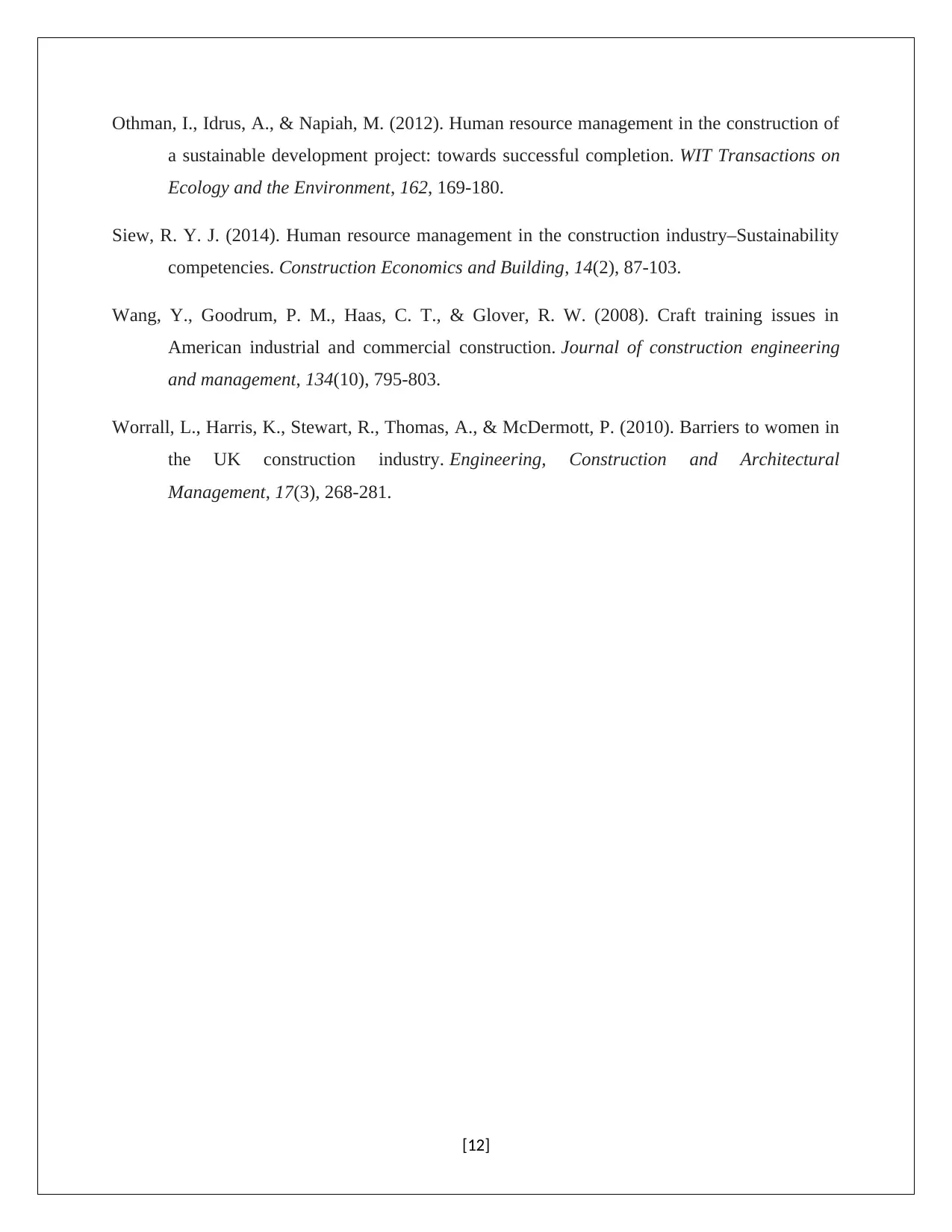
Othman, I., Idrus, A., & Napiah, M. (2012). Human resource management in the construction of
a sustainable development project: towards successful completion. WIT Transactions on
Ecology and the Environment, 162, 169-180.
Siew, R. Y. J. (2014). Human resource management in the construction industry–Sustainability
competencies. Construction Economics and Building, 14(2), 87-103.
Wang, Y., Goodrum, P. M., Haas, C. T., & Glover, R. W. (2008). Craft training issues in
American industrial and commercial construction. Journal of construction engineering
and management, 134(10), 795-803.
Worrall, L., Harris, K., Stewart, R., Thomas, A., & McDermott, P. (2010). Barriers to women in
the UK construction industry. Engineering, Construction and Architectural
Management, 17(3), 268-281.
[12]
a sustainable development project: towards successful completion. WIT Transactions on
Ecology and the Environment, 162, 169-180.
Siew, R. Y. J. (2014). Human resource management in the construction industry–Sustainability
competencies. Construction Economics and Building, 14(2), 87-103.
Wang, Y., Goodrum, P. M., Haas, C. T., & Glover, R. W. (2008). Craft training issues in
American industrial and commercial construction. Journal of construction engineering
and management, 134(10), 795-803.
Worrall, L., Harris, K., Stewart, R., Thomas, A., & McDermott, P. (2010). Barriers to women in
the UK construction industry. Engineering, Construction and Architectural
Management, 17(3), 268-281.
[12]
⊘ This is a preview!⊘
Do you want full access?
Subscribe today to unlock all pages.

Trusted by 1+ million students worldwide
1 out of 12
Related Documents
Your All-in-One AI-Powered Toolkit for Academic Success.
+13062052269
info@desklib.com
Available 24*7 on WhatsApp / Email
![[object Object]](/_next/static/media/star-bottom.7253800d.svg)
Unlock your academic potential
Copyright © 2020–2025 A2Z Services. All Rights Reserved. Developed and managed by ZUCOL.




